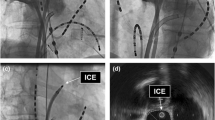Conclusions
TEE is a useful tool to investigate patients undergoing ablation therapy of atrial fibrillation. The technique provides important information about the presence of thrombus and SEC in the left atrium and LAa, and about minor IAS abnormalities, which seem to occur more frequently than in the normal population. Such information is necessary for planning the approach to the PV by catheters that must cross the septum and the atrial cavity.
After ablation, TEE can be used to monitor possible minor complications, such as a residual IAS shunt or pericardial effusion. It also allows the detection of PV stenosis, a rare but dreaded complication of PVAI. A control TEE examination 3 months after the ablation procedure is probably adequate for this purpose.
Access this chapter
Tax calculation will be finalised at checkout
Purchases are for personal use only
Preview
Unable to display preview. Download preview PDF.
Similar content being viewed by others
References
Marrouche NF, Martin DO, Wazni O et al (2003) Phased-array intracardiac echocardiography monitoring during pulmonary vein isolation in patients with atrial fibrillation. Impact on outcome and complications. Circulation 107:2710–2716
Lopez-Candales A, Grewal H, Katz W (2005) The importance of increased interatrial septal thickness in patients with atrial fibrillation: a transesophageal echocardiographic study. Echocardiography 22(5):408–414
Jordan RA, Scheifley CH, Edwards JE (1951) Mural thrombosis and arterial embolism in mitral stenosis: a clinical pathologic study of fifty-one cases. Circulation 3:363–367
Leung DYC, Black IW, Cranney GB et al (1994) Prognostic implications of left atrial spontaneous echocontrast in nonvalvular atrial fibrillation. J Am Coll Cardiol 24:755–762
Goldman ME, Pearce LA, Hart RG et al (1999) Pathophysiologic correlates of thromboembolism in nonvalvular atrial fibrillation: reduced flow velocity in the left atrial appendage (The Stroke Prevention in Atrial Fibrillation [SPAF-III] study). J Am Soc Echocardiogr 12(12):1080–1087
Kronzon I, Tunick PA, Glassman E et al (1990) Transesophageal echocardiography to detect atrial clots in candidates for percutaneous transseptal mitral balloon valvuloplasty. J Am Coll Cardiol 16:1320–1322
Piovesana P, Toffanin G, De Piccoli B et al (2005) Studio di confronto fra eco transesofageo e risonanza magnetica nucleare nella valutazione delle varianti anatomiche delle vene polmonari nei pazienti sottoposti ad ablazione della fibrillazione atriale. Ital Heat J 6:S28 (abs)
Kato R, Lickfett L, Meininger G et al (2003) Pulmonary vein anatomy in patients undergoing catheter ablation of atrial fibrillation: lessons learned by use of magnetic resonance imaging. Circulation 107(15):2004–2010
Saad EB, Rossillo A, Saad CP et al (2003) Pulmonary vein stenosis after radiofrequency ablation of atrial fibrillation: functional characterization, evolution, and influence of the ablation strategy. Circulation 108(25):3102–3107
Tucker KJ, Curtis AB, Murphy J et al (1996) Transesophageal echocardiographic guidance of transseptal left heart catheterisation during radiofrequency ablation of left-sided accessory pathways in humans. Pacing Clin Electrophysiol 19:272–281
Haïssaguerre M, Jaïs P, Shan DC et al (2000) Electrophysiological end point for catheter ablation of atrial fibrillation initiated from multiple pulmonary venous foci. Circulation 101:1409–1417
Schwartzman D, Lacomis J, Wigginton WG (2003) Characterization of left atrium and distal pulmonary vein morphology using multidimensional computed tomography. J Am Coll Cardiol 41:1349–1357
Yu W, Hsu T, Tai C et al (2001) Acquired pulmonary vein stenosis after radiofrequency catheter ablation of paroxysmal atrial fibrillation. J Cardiovasc Electrophysiol 12:887–892
Stoddart MF, Dawkins PR, Prince CR, Longaker RA (1995) Transesophageal echocardiographic guidance of cardioversion in patients with atrial fibrillation. Am Heart J 129:1204–1215
Author information
Authors and Affiliations
Editor information
Editors and Affiliations
Rights and permissions
Copyright information
© 2006 Springer-Verlag Italia
About this chapter
Cite this chapter
De Piccoli, B., Rossillo, A. (2006). Value of Transoesophageal Echocardiography for the Ablation of Atrial Fibrillation. In: Raviele, A. (eds) Cardiac Arrhythmias 2005. Springer, Milano. https://doi.org/10.1007/88-470-0371-7_26
Download citation
DOI: https://doi.org/10.1007/88-470-0371-7_26
Publisher Name: Springer, Milano
Print ISBN: 978-88-470-0370-5
Online ISBN: 978-88-470-0371-2
eBook Packages: MedicineMedicine (R0)




